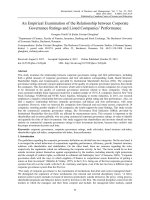FM11 Ch 25 Mergers, LBOs, Divestitures, and Holding Companies
Bạn đang xem bản rút gọn của tài liệu. Xem và tải ngay bản đầy đủ của tài liệu tại đây (127.58 KB, 47 trang )
25 - 1
.
Types of mergers
Merger analysis
Role of investment bankers
LBOs, divestitures, and holding
companies
CHAPTER 25
Mergers, LBOs, Divestitures,
and Holding Companies
25 - 2
.
Synergy: Value of the whole
exceeds sum of the parts. Could
arise from:
Operating economies
Financial economies
Differential management efficiency
Taxes (use accumulated losses)
What are some valid economic
justifications for mergers?
(More )
25 - 3
.
Break-up value: Assets would be
more valuable if broken up and
sold to other companies.
25 - 4
.
Diversification
Purchase of assets at below
replacement cost
Acquire other firms to increase
size, thus making it more difficult
to be acquired
What are some questionable
reasons for mergers?
25 - 5
.
Five Largest Completed Mergers
(as of January 2003)
VALUE
BUYER TARGET
(Billion)
Vodafone AirTouch Mannesman
$161
Pfizer Warner-Lambert
116
America Online Time Warner
106
Exxon Mobil
81
Glaxo Wellcome SmithKline Beecham
74
25 - 6
.
Friendly merger:
The merger is supported by the
managements of both firms.
Differentiate between hostile and
friendly mergers
(More )
25 - 7
.
Hostile merger:
Target firm’s management resists
the merger.
Acquirer must go directly to the
target firm’s stockholders, try to
get 51% to tender their shares.
Often, mergers that start out
hostile end up as friendly, when
offer price is raised.
25 - 8
.
Access to new markets and
technologies
Multiple parties share risks and
expenses
Rivals can often work together
harmoniously
Antitrust laws can shelter
cooperative R&D activities
Reasons why alliances can make more
sense than acquisitions
25 - 9
.
Reason for APV
Often in a merger the capital
structure changes rapidly over the
first several years.
This causes the WACC to change
from year to year.
It is hard to incorporate year-to-year
changes in WACC in the corporate
valuation model.
25 - 10
.
The APV Model
Value of firm if it had no debt
+ Value of tax savings due to debt
= Value of operations
First term is called the unlevered value
of the firm. The second term is
called the value of the interest tax
shield.
(More )
25 - 11
.
APV Model
Unlevered value of firm = PV of FCFs
discounted at unlevered cost of
equity, r
sU
.
Value of interest tax shield = PV of
interest tax savings at unlevered
cost of equity. Interest tax savings =
Interest(tax rate) = TS
t
.
25 - 12
.
Note to APV
APV is the best model to use when
the capital structure is changing.
The Corporate Valuation model is
easier than APV to use when the
capital structure is constant—such
as at the horizon.
25 - 13
.
Steps in APV Valuation
1. Project FCF
t
,TS
t
, horizon growth rate,
and horizon capital structure.
2. Calculate the unlevered cost of equity,
r
sU
.
3. Calculate WACC at horizon.
4. Calculate horizon value using constant
growth corporate valuation model.
5. Calculate V
ops
as PV of FCF
t
, TS
t
and
horizon value, all discounted at r
sU
.
25 - 14
.
Net sales $60.0 $90.0 $112.5
$127.5
Cost of goods sold (60%) 36.0 54.0 67.5
76.5
Selling/admin. expenses 4.5 6.0 7.5
9.0
EBIT 19.5 30.0 37.5
42.0
Taxes on EBIT (40%) 7.8 12.0 15.0
16.8
NOPAT 11.7 18.0 22.5
25.2
Net Retentions 0.0 7.5 6.0
4.5
Free Cash Flow 11.7 10.5 16.5
20.7
APV Valuation Analysis (In Millions)
2005 2006 2007 2008
Free Cash Flows after Merger Occurs
25 - 15
.
Interest Tax Savings after Merger
Interest expense 5.0 6.5 6.5 7.0
Interest tax savings 2.0 2.6 2.6 2.8
Interest tax savings are calculated as
interest(T). T = 40%
2005 2006 2007 2008
25 - 16
.
What are the net retentions?
Recall that firms must reinvest in
order to replace worn out assets and
grow.
Net retentions = gross retentions –
depreciation.
25 - 17
.
After acquisition, the free cash flows belong
to the remaining debtholders in the target
and the various investors in the acquiring
firm: their debtholders, stockholders, and
others such as preferred stockholders.
These cash flows can be redeployed within
the acquiring firm.
Conceptually, what is the appropriate
discount rate to apply to the
target’s cash flows?
(More )
25 - 18
.
Free cash flow is the cash flow that
would occur if the firm had no debt,
so it should be discounted at the
unlevered cost of equity.
The interest tax shields are also
discounted at the unlevered cost of
equity.
25 - 19
.
Note: Comparison of APV with
Corporate Valuation Model
APV discounts FCF at r
sU
and adds in
present value of the tax shields—the value
of the tax savings are incorporated
explicitly.
Corp. Val. Model discounts FCF at WACC,
which has a (1-T) factor to account for the
value of the tax shield.
Both models give same answer IF
carefully done. BUT it is difficult to apply
the Corp. Val. Model when WACC is
changing from year-to-year.
25 - 20
.
Discount rate for Horizon Value
At the horizon the capital structure is
constant, so the corporate valuation
model can be used, so discount
FCFs at WACC.
25 - 21
.
Discount Rate Calculations
r
sL
= r
RF
+ (r
M
- r
RF
)b
Target
= 7% + (4%)1.3 = 12.2%
r
sU
= w
d
r
d
+ w
s
r
sL
= 0.20(9%) + 0.80(12.2%) = 11.56%
WACC = w
d
(1-T)r
d
+ w
s
r
sL
=0.20(0.60)9% + 0.80(12.2%)
= 10.84%
25 - 22
.
Horizon value =
=
= $453.3 million.
Horizon, or Continuing, Value
g WACC
g))(1(FCF
2008
−
+
06.01084.0
)06.1(7.20$
−
25 - 23
.
What Is the value of the Target Firm’s
operations to the Acquiring Firm? (In
Millions)
2005 2006 2007 2008
Free Cash Flow $11.7 $10.5 $16.5 $ 20.7
Horizon value 453.3
Interest tax shield 2.0 2.6 2.6 2.8
Total $13.7 $13.1 $19.1 $476.8
V
Ops
= + + +
= $344.4 million.
$13.7
(1.1156)
1
$13.1
(1.1156)
2
$19.1
(1.1156)
3
$476.8
(1.1156)
4
25 - 24
.
What is the value of the Target’s
equity?
The Target has $55 million in debt.
Vops – debt = equity
344.4 million – 55 million = $289.4
million = equity value of target to the
acquirer.
25 - 25
.
No. The cash flow estimates would
be different, both due to forecasting
inaccuracies and to differential
synergies.
Further, a different beta estimate,
financing mix, or tax rate would
change the discount rate.
Would another potential acquirer
obtain the same value?









